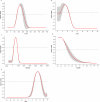Projecting suitable habitats and prioritizing conservation areas for Dendrobium shixingense under climate change
- PMID: 40860726
- PMCID: PMC12370663
- DOI: 10.3389/fpls.2025.1620580
Projecting suitable habitats and prioritizing conservation areas for Dendrobium shixingense under climate change
Abstract
Dendrobium shixingense Z. L. Chen, S. J. Zeng & J. Duan, a National Class II Protected wild plant species in China, is renowned for its rich polysaccharide content and remarkable medicinal value. Delineating priority conservation areas for this species is critically important for its sustainable conservation and management. In this study, the MaxEnt model was applied to predict its potential distribution patterns under multiple climate scenarios, while the Marxan and InVEST models were utilized to identify priority conservation zones. Results demonstrate that the primary distribution of D. shixingense is concentrated in southeastern China, particularly within Guangdong, Fujian, Guangxi, and Jiangxi provinces, with a total suitable habitat area of 79.41 × 104km2. Future projections indicate an expansion of suitable habitats, with key environmental drivers identified as precipitation of the coldest quarter (Bio19), mean diurnal temperature range (Bio2), among others. Priority conservation areas are predominantly located in Shixing County and Ruyuan Yao Autonomous County of Shaoguan City; Xing'an County of Guilin City and other specified regions. These findings indicate that climate change will substantially impact the distribution of D. shixingense, potentially altering both the extent and quality of suitable habitats. priority conservation areas are concentrated in ecologically stable regions, necessitating enhanced protection efforts in these zones. Collectively, this research provides a robust scientific foundation for formulating effective conservation strategies and advancing the sustainable development of D. shixingense.
Keywords: Dendrobium shixingense Z. L. Chen; InVEST; Marxan; MaxEnt; S. J. Zeng & J. Duan; Suitable area; priority protected area.
Copyright © 2025 Lin, Ren, Fan, Deng, Liu, Zhang, Xu, Huang, Zhang and Qi.
Conflict of interest statement
The authors declare that the research was conducted in the absence of any commercial or financial relationships that could be construed as a potential conflict of interest.
Figures











References
-
- Aiello-Lammens M. E., Boria R. A., Radosavljevic A., Vilela B., Anderson R. P. (2015). spThin: an R package for spatial thinning of species occurrence records for use in ecological niche models. Ecography 38, 541–545. doi: 10.1111/ecog.01132 - DOI
-
- Arabameri A., Pradhan B., Rezaei K., Conoscenti C. (2019). Gully erosion susceptibility mapping using GIS-based multi-criteria decision analysis techniques. Catena 180, 282–297. doi: 10.1016/j.catena.2019.04.032 - DOI
-
- Ball I., Possingham H. (2000). Marxan (Brisbane, Australia: University of Queensland; ).
-
- Beaumont L. J., Hughes L., Poulsen M. (2005). Predicting species distributions: use of climatic parameters in BIOCLIM and its impact on predictions of species’ current and future distributions. Ecol. Model. 186, 251–270. doi: 10.1016/j.ecolmodel.2005.01.030 - DOI
LinkOut - more resources
Full Text Sources

